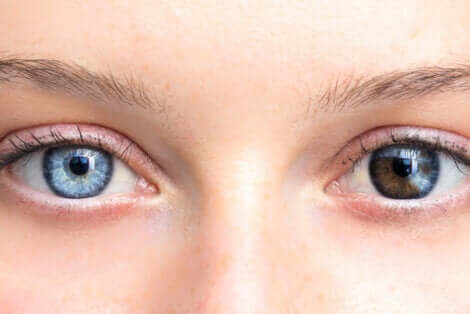Eyes Changing Color: Truths and Myths

Eye color, just like skin and hair color, is related to an individual’s melanin production. Some people experience their eyes changing color during their lifetime for varying reasons. In this article, we’ll debunk some of the myths surrounding this topic.
There are more than 150 genes involved in the production, transportation, and storage of melanin. Melanin is what gives pigment and ultimately defines the color of a person’s eyes.
People who have light eyes in the blue-green range don’t produce or store large amounts of melanin. On the other hand, those with darker eyes, ranging from dark brown to black, do.
How is eye color determined?
According to an article published in the journal Missouri Medicine, human eye color is determined by the density and size of melanocytes, which are the cell structures that make melanin. Melanocytes are all across the iris stroma and influence eye color and shade.
The above article also explains that the gene OCA2 on the 15th chromosome produces the protein responsible for creating and processing melanin. The more active this gene is, the more melanin it produces, resulting in darker eye colors. However, there are other genes that can affect eye color, and several of them involve lighter colors like blues and greens.
You might like: 5 Things Your Eyes Say About Your Health
What does the iris do?
The iris is a flat, ring-shaped membrane made of connective tissue and muscle fibers. It’s located behind the cornea and surrounds the pupil. The iris is the part of the eye that has color and, along with the pupil, controls how much light makes it into the eye.
The muscle fibers in the iris help expand and shrink the pupil to allow light to enter the eye. When working properly, this function happens naturally as a response to the amount of light in the environment.
According to the American Academy of Ophthalmology, sometimes it can seem like your eyes are changing color, but more often than not it’s just a trick of the light. Changes in light cause the pupil to dilate, which can also make it appear like your eyes are a different color and is only temporary.
However, if you notice an obvious change in your eye color, in either one or both eyes, you should contact an optometrist immediately. Eyes changing color is actually quite rare and can be a sign of illness like uveitis, hepatitis, or aniridia from medication or eye trauma.

Common beliefs about eyes changing color
There are many beliefs about how and why eyes might change color. We’re here to help you identify which are true and which are myths.
We’re born with a different eye color
True. During the first few months of life, the melanocytes are just getting started and haven’t produced all of your body’s melanin. Therefore, a newborn’s eye color will likely change continuously over time.
An article published in the American Academy of Pediatrics points out that melanocytes take about a year to produce all the melanin in your body. In other words, a baby’s gray or blue eyes might turn a darker shade during its first year of life.
It’s possible that some babies are born with conditions affecting their pigmentation, such as albinism or heterochromia, in which case one eye might be different than the other or one eye may contain many different colors. Accidents, genetic factors, illness, or disease can all cause this condition.
Green eyes are the result of a genetic mutation
False. Green eyes are not the result of a genetic mutation, rather the result of moderate melanin production and a mid-range density of melanocytes, as suggested by this article in Genetics of Eye Color.
Another article, published in the International Journal of Molecular Sciences, proposed that eye color is not determined by the number of melanocytes. Instead, according to the study, it’s the melanin composition that affects eye color. There are three kinds of melanin: eumelanin, pheomelanin, and neuromelanin. Only pheomelanin affects eye color.
Discover: What Your Eye Color Says About You
Eye color can change with your mood
False. Your mood doesn’t change your eye color or, at least, there aren’t any studies to support this claim.
As we mentioned before, changes in light make the pupil dilate to adjust to the brighter or darker environment. When this happens, less of the iris is visible, which can trick you into thinking your eye is a different color. Additionally, your eyes might even reflect the color of a nearby object, further attributing to this misperception.
You can change the color of your eyes with surgery
This is true, but we don’t recommend it. In addition to using color contacts, there are two surgeries that can change the look of the iris. One of these is a prosthetic iris implant, which was approved by the Food and Drug Administration (FDA) in 2018.
This type of surgery began as a way to treat birth defects and fix the eye after an accident. However, it quickly became a popular cosmetic procedure to change eye color.
Most medical professionals would advise against subjecting healthy eyes to this surgery, as it can compromise proper eye function if something goes wrong. Some of the risks of this surgery are an increase in intraocular pressure, intraocular swelling, corneal edema, loss of vision, and glaucoma.
The second type of surgery is corneal keratopigmentation, more commonly known as corneal tattooing. This procedure is for patients with varying degrees of blindness causing opaque spots on the eye.
Corneal tattooing helps reduce the appearance of the affected eye while posing few risks, making it a good option for treatment and cosmetics. For people looking to use this technique for cosmetic purposes, a clinical study assessing the mid- to long-term effects of the procedure found it can cause sensitivity to light, eye discoloration, and keratitis.

Take care of your eyes
Our eyes help us take in the world around us and carry out daily activities with ease. In fact, vision is considered to be the most dominant of the five senses. Although you might not like your eye color, it’s important to remember that these procedures can cause irreparable damage to your eyes and eyesight.
After the first year of life, your eyes typically stay the same color. If you notice changes in your eye color, visit your optometrist. They will help you understand why the changes occurred and what you can do to keep your eyes healthy.
https://mejorconsalud.as.com/cambiar-color-ojos-verdades-mitos/
All cited sources were thoroughly reviewed by our team to ensure their quality, reliability, currency, and validity. The bibliography of this article was considered reliable and of academic or scientific accuracy.
- Eissenberg JC. More than Meets the Eye: Eye Color and Alcoholism. Mo Med. 2016;113(2):98-103.
- Rauch K. Why Are My Eyes Changing Color?. American Academy of Ophthalmology [Internet]. 2019 Feb, 28. Disponible en: https://www.aao.org/eye-health/tips-prevention/why-are-my-eyes-changing-color
- Hill D. Newborn Eye Color. American Academy of Pediatrics [Internet]. 2020 Aug, 06. Disponible en: https://www.healthychildren.org/English/ages-stages/baby/Pages/Newborn-Eye-Color.aspx
- Houtzagers LE, Wierenga APA, Ruys AAM, Luyten GPM, Jager MJ. Iris Colour and the Risk of Developing Uveal Melanoma. Int J Mol Sci. 2020 Sep 28;21(19):E7172. doi: 10.3390/ijms21197172. PMID: 32998469.
- El Chehab H, Gatinel D, Baudouin C, Muraine M, Hoffart L, Rozot P, Mehanna C, Bonnet C, Nordmann JP, Santiago PY, Burillon C, Baillif S, Pisella PJ, Weber M, Robinet-Perrin A, Deidier D, Hay A, Villain M, Baïkoff G, Gauthier AS, Mathis T, Dot C. Complications of cosmetic iris implants: French series of 87 eyes. J Cataract Refract Surg. 2020 Jan;46(1):34-39. doi: 10.1097/j.jcrs.0000000000000032. PMID: 32050230.
- Hasani H, Es’haghi A, Rafatnia S, Alilou S, Abolmaali M. Keratopigmentation: a comprehensive review. Eye (Lond). 2020 Jun;34(6):1039-1046. doi: 10.1038/s41433-019-0750-2. Epub 2020 Jan 2. PMID: 31896801; PMCID: PMC7253443.
- DʼOria F, Alio JL, Rodriguez AE, Amesty MA, Abu-Mustafa SK. Cosmetic Keratopigmentation in Sighted Eyes: Medium- and Long-term Clinical Evaluation. Cornea. 2020 Jul 29. doi: 10.1097/ICO.0000000000002417. Epub ahead of print. PMID: 32740012.
This text is provided for informational purposes only and does not replace consultation with a professional. If in doubt, consult your specialist.








